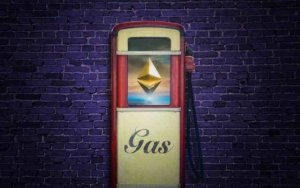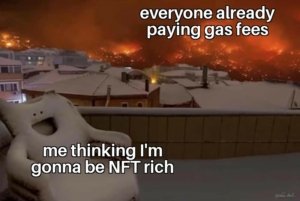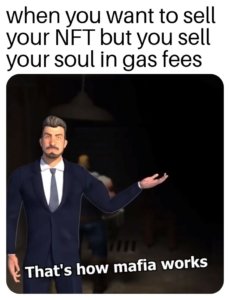 You’re asking yourself, “How can I make some money on NFTs?” when you should really be asking, “What are NFT gas fees?” With just about everyone talking, tweeting, and generally bragging about NFTs, it seems like the easiest thing in the world to just hop on the blockchain with your amazing idea and make a few bucks, right? Well, STOP RIGHT THERE because there’s a harsh reality you’ll have to face before you can start raking in those crypto profits.
You’re asking yourself, “How can I make some money on NFTs?” when you should really be asking, “What are NFT gas fees?” With just about everyone talking, tweeting, and generally bragging about NFTs, it seems like the easiest thing in the world to just hop on the blockchain with your amazing idea and make a few bucks, right? Well, STOP RIGHT THERE because there’s a harsh reality you’ll have to face before you can start raking in those crypto profits.
Whether you’re flipping NFTs, buying and holding collectibles, or creating and selling your own art, everyone has to deal with the same issue: Ethereum gas fees. Don’t worry, we’ll get into what that means and how to deal with it. But first, we’ll prepare our minds and bodies with a meme.
Terms to know
If you’re new to the crypto or NFT marketplace, you’ll probably want to know a few basic terms. You can also get a little more in-depth with the jargon here. If you want to check out some of the common NFT misconceptions, here are 5 misconceptions about NFTs that newcomers have.
 Gas fees
Gas fees
Gas fees are simply transaction fees paid for completing a blockchain transaction. The decentralized ledger is maintained by miners who receive a fee when blocks are added to the chain.
Minting
When you create a piece of art, it’s not tokenized until you place it on the blockchain — this is called minting. Once your art is minted, you can then sell it as an NFT.
Layer 1
A “layer 1” is the blockchain base layer which is basically a big, decentralized database. Bitcoin, Ethereum, and Solana are all layer 1s.
Layer 2
A “layer 2” is a secondary protocol that operates on top of the blockchain base layer. Things like Polygon are layer 2s which are intended to increase scalability.
What are NFT gas fees going to look like?
 Now, you may be thinking, what’s the big deal? So I have to pay a transaction fee to sell my NFT, that’s fine. Because, of course, your art is super collectible and super valuable, right? I don’t doubt you! But not so fast. By the time you get your beautiful creation tokenized and sold, you’ll run into more than one li’l ol’ Ethereum gas fee.
Now, you may be thinking, what’s the big deal? So I have to pay a transaction fee to sell my NFT, that’s fine. Because, of course, your art is super collectible and super valuable, right? I don’t doubt you! But not so fast. By the time you get your beautiful creation tokenized and sold, you’ll run into more than one li’l ol’ Ethereum gas fee.
Get ETH
Unless you already have a crypto wallet stuffed full of ETH, you’re going to have to get some. Depending on how you buy it, you may have to pay some trading fees and gas fees to send ETH from an exchange to your wallet.
Get a wallet
And, of course, in order to send ETH to your wallet, you need to have a wallet. Because transaction costs can fluctuate pretty wildly, you never know exactly how much crypto you’ll need. So make sure you have a good amount because multiple extra transactions will cost multiple extra Ethereum gas fees.
Mint your NFT
Once you’re ready with your art, minting and listing it on an NFT marketplace is the next step. You can read more about reducing wallet fees and a breakdown of how minting fees might work out through the whole process here.
Sell your NFT
Obviously everyone will rush eagerly to buy your newly minted NFT. But if you’re a first-time seller, depending on the NFT marketplace, you may have to pay gas fees to get started before you can start “lazy minting.”
Collect your profits
You wouldn’t be making a profit if you weren’t losing a small cut, now would you? That’s how the mafia the NFT marketplace works! To get your crypto profits out of the NFT marketplace and back to your wallet, it takes — guess what — Ethereum gas fees!
How to reduce Ethereum gas fees
 So now that you’re probably thoroughly demoralized wondering how on earth you can even turn a profit in this dang business, take heart! There are some things you can do to reduce your gas fee costs. Not to mention, the industry knows this is a problem and is working on it… if slowly.
So now that you’re probably thoroughly demoralized wondering how on earth you can even turn a profit in this dang business, take heart! There are some things you can do to reduce your gas fee costs. Not to mention, the industry knows this is a problem and is working on it… if slowly.
Timing
Layer 1 transaction volume does fluctuate, so one of the ways you can help reduce the amount of fees you pay is by timing your transactions to those times with less network congestion. Weekends can be a fairly safe bet, but you can also use tools like Ycharts to see the number of transactions over the past several days to find traffic trends.
Consolidating
As I mentioned earlier, keeping your transactions to an absolute minimum will help reduce your Ethereum gas fees. Whether it is from an exchange to your wallet, or in and out of an NFT marketplace, do your best to make as few transactions as possible.
Layer 2s
Sometimes using layer 2 solutions like Polygon can help. By minting your NFT on a layer 2, you can do it for extremely low gas fees. Just be aware that, since layer 2 solutions are relatively new, your NFTs may not be as marketable as those minted directly on the Ethereum layer 1.
Alt chains
If you want to skip Ethereum gas fees altogether, try minting your NFTs on a completely different layer 1. There’s a growing NFT marketplace on chains like Solana, which has extremely low gas fees. Similarly to the layer 2 solution, the buyer’s market may be a bit smaller.
Sell a butt-ton of insanely popular NFTs
The best way to stop worrying about gas fees is to sell so many extremely expensive NFTs that you don’t even care how much Ethereum Gas fees are. This is honestly the best advice, just don’t ask me how to actually accomplish it ‘cause if I knew, I wouldn’t be here, would I?
Don’t make mistakes
Another solid way to make sure you don’t lose money unnecessarily is to always check and double check what you’re doing so you don’t make any “Oops, sold my $1 million NFT for a penny” mistakes.
Why are gas fees so high, and is it changing?
 This might be a bit overwhelming at first, but don’t worry. The NFT space is a lot of fun both for buyers and sellers. Plus, as I mentioned before, the crypto space moves fast and is constantly being developed. Solutions are on the way, even if they’re not quite here yet.
This might be a bit overwhelming at first, but don’t worry. The NFT space is a lot of fun both for buyers and sellers. Plus, as I mentioned before, the crypto space moves fast and is constantly being developed. Solutions are on the way, even if they’re not quite here yet.
The reason Ethereum gas fees are so high is because scalability is still not where it should be. Some solutions on the horizon are the (hopefully) soon coming Eth 2.0 upgrade, which is supposed to speed up the network and hopefully layer 2s like Polygon.
There’s also the possibility of Ethereum losing a bit of ground as far as market share and alternate layer 1s, splitting the NFT marketplace more evenly.
What are NFT gas fees going to be in the future?
If innovation keeps moving the crypto space forward, perhaps in the future you will be asking, “What are NFT gas fees?” for a different reason — because they’re a thing of the past. It’s possible there will be gas-free solutions coming. But for now, trade with your endgame in mind. If you want to see a multichain future, maybe do your trades on Solana NFT marketplaces. If you love Ethereum but hate Ethereum gas fees, use layer 2 solutions. Crypto will grow and change depending on what we tell it to do; that “we” includes you.
About the Author

Michael Hearne
About Decentral Publishing
Decentral Publishing is dedicated to producing content through our blog, eBooks, and docu-series to help our readers deepen their knowledge of cryptocurrency and related topics. Do you have a fresh perspective or any other topics worth discussing? Keep the conversation going with us online at: Facebook, Twitter, Instagram, and LinkedIn.


